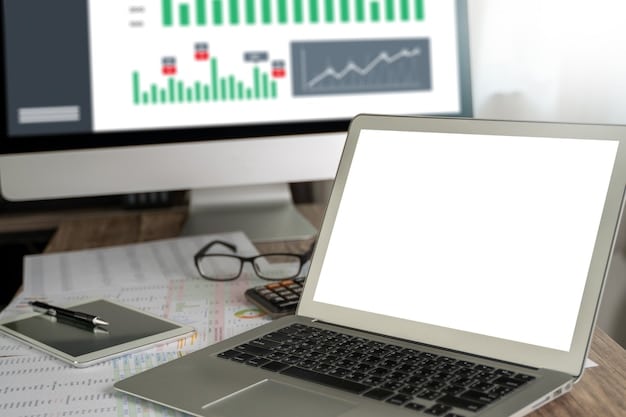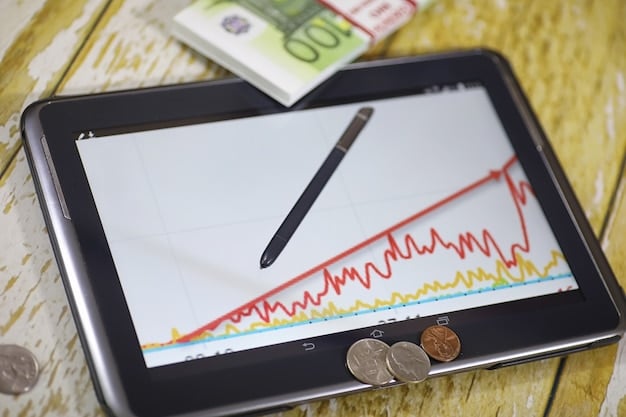Peer-to-Peer Lending in 2025: A Data-Driven Passive Income Analysis

Peer-to-peer (P2P) lending’s viability as a passive income stream in 2025 hinges on economic conditions, regulatory changes, and platform performance, demanding a data-driven assessment of risks and returns.
Is peer-to-peer lending still a viable passive income stream in 2025? A data-driven analysis is essential to understand the current landscape and future possibilities. Let’s explore the factors shaping P2P lending’s potential.
Understanding Peer-to-Peer Lending
Peer-to-peer (P2P) lending has emerged as an alternative investment strategy, connecting borrowers directly with lenders, bypassing traditional financial institutions. This approach can offer attractive returns for investors seeking passive income.
However, understanding the mechanics and intricacies of P2P lending is crucial before diving in. What are the key elements that make up this investment model?
How P2P Lending Works
P2P lending platforms facilitate connections between individuals or businesses seeking loans and investors willing to provide the capital. These platforms handle the loan origination, servicing, and collection processes.
- Borrower Application: Borrowers apply for loans through the platform, providing information about their creditworthiness.
- Risk Assessment: The platform assesses the borrower’s risk profile using credit scores, income verification, and other relevant data.
- Loan Listing: Approved loan requests are listed on the platform, allowing investors to review and select loans to fund.
- Funding: Investors contribute funds to the loan, and once fully funded, the loan is disbursed to the borrower.
The platform collects payments from the borrower and distributes the principal and interest to the investors, less any service fees.
P2P lending offers borrowers access to financing that may not be available through traditional channels, while investors can earn returns higher than those from savings accounts or bonds.

Over time, P2P lending platforms may evolve in response to market demand or technological advancements.
The Current State of P2P Lending
To determine the viability of P2P lending in 2025, it’s essential to examine the current state of the industry and identify key trends shaping its trajectory. Factors such as market size, growth rate, and regulatory changes play a significant role.
P2P platforms have seen significant growth over the past decade. What do the numbers show about its current health?
Market Size and Growth
The P2P lending market has experienced substantial growth in recent years, driven by increasing awareness and adoption of alternative investment strategies. According to market research reports, the global P2P lending market is projected to reach significant figures by 2025. This growth is fueled by factors such as:
- Technological Advancements: Online platforms make it easier for borrowers and lenders to connect, reducing transaction costs.
- Low-Interest Rate Environment: Traditional savings accounts offer low returns, pushing investors to seek alternative options.
- Accessibility: P2P lending platforms often cater to borrowers who may not qualify for traditional bank loans.
However, the growth rate may vary depending on regulatory developments and economic conditions.
Regulation significantly impacts the operation of these platforms. So, what rules exist and how might they evolve?

Regulatory Landscape and Compliance
Regulatory frameworks governing P2P lending vary across jurisdictions, impacting the operations and risk profiles of platforms. Compliance with these regulations is crucial for maintaining investor confidence and ensuring the sustainability of the industry.
Different jurisdictions have different approaches to regulating P2P lending. Let’s consider the U.S. market as an example.
Regulatory Developments in the U.S.
In the United States, P2P lending platforms are subject to various federal and state regulations, including securities laws, consumer protection laws, and anti-money laundering (AML) regulations. The Securities and Exchange Commission (SEC) oversees the issuance of securities by P2P lending platforms, requiring registration and disclosure requirements.
The SEC requires platforms to provide detailed information to investors, including:
- Loan Performance Data: Historical data on loan defaults, charge-offs, and recovery rates.
- Risk Disclosures: Clear warnings about the risks associated with P2P lending.
- Financial Statements: Audited financial statements to ensure transparency and accountability.
Additionally, state regulations may impose further requirements, such as licensing and capital adequacy standards. P2P platforms must carefully navigate this complex regulatory landscape to ensure compliance and mitigate legal risks.
The effectiveness of these platforms depends on their ability to compete on rates and user experience. Will they be able to maintain appealing options in 2025?
Potential Returns and Risks
P2P lending offers the potential for attractive returns, but it also entails certain risks that investors must carefully consider. Understanding these risks and implementing appropriate risk management strategies is essential for maximizing returns and minimizing losses.
One of the main reasons people turn to P2P lending is the promise of returns. What rates of return might investors see?
Expected Returns on P2P Investments
The expected returns on P2P investments depend on various factors, including the credit quality of borrowers, loan terms, and platform fees. Historically, P2P lending platforms have offered returns ranging from 5% to 10% or more, surpassing those of traditional fixed-income investments. However, these returns come with inherent risks.
To mitigate risks, investors should:
- Diversify Investments: Spread funds across multiple loans to reduce the impact of any single loan default.
- Assess Risk Tolerance: Invest only what they can afford to lose, as P2P investments are not FDIC-insured.
- Monitor Portfolio Performance: Regularly track loan performance and make adjustments as needed.
By carefully managing their P2P lending portfolios and staying informed about market conditions, investors can enhance their potential returns while minimizing risks.
Economic conditions can significantly impact borrowers and the overall performance of loan portfolios. How might we see this play out in 2025?
Economic Factors and Market Trends
Economic factors, such as interest rates, unemployment levels, and consumer confidence, can significantly impact the performance of P2P lending platforms. Monitoring these factors is crucial for assessing the viability of P2P lending in 2025.
How can the general economic climate shape the behavior of borrowers and lenders on these platforms?
Impact of Economic Conditions
In a strong economy, with low unemployment rates and rising consumer confidence, borrowers are more likely to repay their loans, resulting in lower default rates and higher returns for investors. Conversely, during economic downturns, default rates may increase as borrowers struggle to meet their obligations. Factors to consider include:
- Interest Rate Hikes: Rising interest rates may make it more challenging for borrowers to repay their loans, increasing default risk.
- Unemployment: Job losses can lead to a decline in borrowers’ ability to repay their debts.
- Regulatory Changes: New regulations may impact the operations and profitability of P2P lending platforms.
Keeping a close eye on these economic indicators and adapting investment strategies accordingly can help investors navigate the P2P lending landscape successfully.
P2P lending platforms are susceptible to cyber threats. What security measures should be in place to protect investors in 2025?
Platform Security and Due Diligence
Evaluating the security measures and due diligence processes of P2P lending platforms is crucial for protecting investors’ funds and personal information. Investors should carefully assess the platform’s track record, security protocols, and data protection policies.
P2P platforms need robust security measures to safeguard user data and funds. What specific precautions should investors be aware of?
Assessing Platform Security Measures
Investors should verify that the platform employs robust security measures, such as encryption, multi-factor authentication, and intrusion detection systems. Look for platforms that have undergone independent security audits and certifications. Additionally, consider the platform’s history of data breaches or security incidents. Due diligence should include verifying:
- Data Encryption: Ensuring sensitive data is encrypted both in transit and at rest.
- Access Controls: Implementing strict access controls to prevent unauthorized access to user accounts.
- Incident Response Plan: Having a well-defined plan to respond to data breaches or security incidents.
By prioritizing platform security and conducting thorough due diligence, investors can minimize the risk of fraud or data breaches and protect their investments.
| Key Aspect | Brief Description |
|---|---|
| 📈 Market Growth | P2P lending is expected to expand, fueled by tech and low-interest rates. |
| 🛡️ Regulatory Risks | Varying regulations necessitate thorough compliance and risk management. |
| 💰 Potential Returns | Returns can be substantial, but investors must manage risks through diversification. |
| 🌐 Economic Factors | Economic downturns can impact borrowers, increasing the default risk. |
Frequently Asked Questions
▼
Peer-to-peer lending involves connecting borrowers directly with lenders, bypassing traditional financial institutions. Platforms facilitate these connections and manage loan processes.
▼
P2P lending platforms typically generate revenue through transaction fees, origination fees charged to borrowers, and service fees deducted from investor returns.
▼
Key risks include borrower default, economic downturns, and platform security vulnerabilities. Diversification and due diligence are essential for managing these risks effectively.
▼
In the United States, P2P lending platforms are subject to various federal and state regulations, including securities laws, consumer protection laws, and anti-money laundering regulations.
▼
Investors should assess their risk tolerance, conduct thorough due diligence on platforms, diversify investments, and stay informed about economic and regulatory developments to secure their investments.
Conclusion
In conclusion, while peer-to-peer lending can offer a viable passive income stream in 2025, it requires thorough research, careful risk management, and continuous monitoring of economic and regulatory factors. By understanding the potential returns and risks, investors can make informed decisions and navigate the P2P lending landscape successfully.





